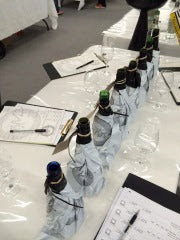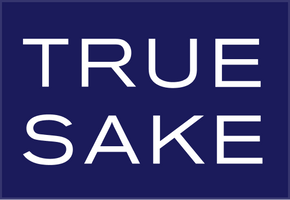Sake Importance – The International Wine Challenge
Can you taste gold? Can you taste a medal? How do you know? How can you taste one sake that stands out from hundreds?
Simple. You can.

I don't want to simplify three days of tasting almost 900 sakes. I don't want to trivialize me personally tasting perhaps close to 200 sakes in about four hours, but in a word, you know. You simply know by the fluid in your mouth – in your “pallet” – that it is an exceptional brew. The sake, as I always say, speaks for itself. It is a liquid “rightness” and that’s it. It's as simple as that.
There was a day long ago when I first started on this sake journey that I used to say that you cannot drink a gold medal! And I was fascinated by Japanese brewers who laid it all on the line for what the “judges” thought about their sakes. They held the judging as their end all be all. I would ask, “Aren’t you pleased enough with the sake that you brew that makes all of your customers so happy?” And they would reply, “I want to know how good my sake really is.” It confused me. It made me want to shake their shoulders and say, “You make sake that is wonderful, what else do you need to know?” But now, nine years later I get it.
Sake competitions like all “judging” competitions are important for those who need to be validated. It’s an inner voice that says, “Sure my family and friends think that I make a good product, but do I?" It’s also an economic incentive to be heralded in the industry in which you dwell and “compete.” So as much importance, validation and trust brewers put into sake judging competition it’s paramount that the competition itself is as solid as their individual efforts. Gold medals should truly be earned and not given.
The International Wine Challenge does not “give" gold medals, nor silver, nor bronze. Each medal and trophy presented is based purely and simply on the strength and virtue of that specific sake. Sakes are awarded for what they truly deserve. This fact became abundantly clear to me this ninth year of my involvement with one of the largest and best sake tastings in the world.

The IWC held in London every April is the largest wine tasting in the world, and is recognized as perhaps the most significant international wine tasting in the history of “judging” wine. Nine years ago this body had the foresight to include sake in the mix. Perhaps it was on account of knuckleheads like myself who implored the Japanese Sake Brewer’s Association via the Sake Samurai to market sake in a new vein and a new direction. (Thank you Koichi Saura of Urakasumi Brewery for leading this charge on behalf of the Sake Samurai.)
I’ll admit that it was nerve wracking nine years ago to be one of the first panel chairman looking at my table with 6 Japanese and 6 western judges looking back at me. In our first incarnation we used the 100 point system to judge each sake. Wow! What a shock that was to see the western judges give a certain brew an 89 and the Japanese judges give the same sake a 59. Gulp! Really? Thirty points apart on the same sake? Who’s tastes did we trust more? Big impact and super flavorful sakes spoke to the west, and light and clean brews appealed to the Japanese tasters. Who was right? And more to the point, who was wrong?
That seems like so long ago! But we managed, and we excelled. And each year the number of sakes and judges increased. This year 16 countries were represented with judges judging sakes from Japan, the US, Norway, and Canada. It’s truly an international competition for a libation that wants to be taken seriously on the international stage, which of course means appealing to tastes from all over the globe.
The first day of tasting was business as usual, and a lot of fun. Basically we separate the wheat from the chaff. It’s a blistering fast day where sakes are judged in three categories; Medal (which means they are medal worthy and will be judged for a specific medal on Day 2), Commend (which means the sake is worth a recommendation, but it’s not medal worthy), and Out (which means the sake is either faulty, damaged, or poorly produced). Each panel was in charge of 96 sakes in multiple flights. As I run a pretty effective panel, we were given 106 sakes.

What do you look for before you spit? Ha! Purity, intensity, complexity, finesse, elegance, and of course, flavor, and most importantly, balance. Basically, as I stated before, the sakes speak for themselves. There is no lying in liquid form. It’s good or it’s not, and if you get it wrong there are 5 other judges who will remind you via their call if a brew is good or not. In the beginning 9 years ago I was a dick. I was very very tough on the sakes. I didn’t push many through. But as time has passed I have learned that the brews have a more global appeal then just my pallet. So as a panel chairman I am more of a consensus accumulator. That’s really our jobs, to listen to the panel and take what they like and drop what they don’t like.
The structure of the tasting panel is as follows: Panel Chair (moi), Senior Judge, Judges, and Assistant Judges. Each year we get reviewed and you progress as well as you taste, meaning a judge who does well eventually becomes a Senior Judge and then a Panel Chair as the event grows and we need new tables. (This year we had nine tables) And then there are two Co-Chairman, who oversee all of the sakes. Yup! That means they taste all of the sakes to make certain that each of the tables are doing their jobs of sending through excellent and medal worthy sakes. Then all of the Table Chairs and the Co-Chairmen select the trophy winners from all of the gold medal sakes. Yes! lots of tasting and a ton of work! But wait! What’s the saying, be careful of what you wish for?
This year I was selected to act as a Co-Chair for the second and most important day of tasting. (So too was my Swedish sake brother, Ake Norgnan, who did day one.) Basically I sat in a separate room and reviewed each and every sake that came through the process along with my other Co-Chairs. It was indeed an immense honor and I left everything on the field of play, the court, in the pool, on the mat etc. It was awesome because it rocked me. I was toast afterwards and it was well worth it, because I could really see the integrity of the IWC product shine through. In a sense we were a double secret security check making certain that the right sakes were awarded and rightfully so. (I have been involved in many “Sake Tastings” and there has always been some trickeration where certain sakes automatically won gold medals, and that is wrong – just saying!)

So how did a white boy from America judging Japanese sakes in the United Kingdom do? I was told that I did very well, and that I was spot on, which means a ton to me, because it’s good to know where your pallet stands amongst some of the greatest sake tasters in the world. Personally I will say that I probably tasted over 200 sakes, and I had my fair share of pushing down a sake as well as elevating a sake. Huh? Each sake we tasted had the panel’s scores and notes, and I could tell if a panel leader was influencing his or her panel too much. I could follow each taster’s personal scores for each brew. I then would taste the sake and concur or say perhaps not! If I disagreed with a medal given, I would then let a fellow Co-Chair taste and make a case. It took three Co-Chairs to change a medal grade.
Again the questions come, how can you taste so many and be accurate? And again I will say it’s the sakes that speak for themselves. Perhaps an anecdote will demonstrate this notion. I was following a certain new Assistant Judge, who did not jibe with her table at all. She continually missed the consensus, which is fine as she was tasting from her perspective, which is the name of the game. Point being I was looking over the panel notes and saw that she had a certain palette profile, which would give Bronze medals to sakes that the entire panel gave gold medals to. Finally she gave a sake a gold medal that the panel gave Commended or Bronze medals to. I tasted the sake and said Aha! She gets it! This is a Gold Med…. Ah wait a second! The sake had a wonderful aroma, the first sip was glorious, (Gold baby Gold!) the middle mouth was succulent and then wham! It hit! Like a slap in the face! The sake spoke! And what it said was CHARCOAL! Right there in the middle mouth after all of the tasting glory was a deep rooted over charcoal taste that simply ruined the sake! Ouch! It was a pity for the sake but it was a good lesson in how the system caught the brew. Pretty cool right!

Day two of the IWC 2015 in London England was one of the greatest sake days of my life. I mean that. Even though it crushed me, I was a zombie for about two hours after the tasting, it made me sake whole again! It gave me faith in myself and my product called the International Wine Challenge. Ironically it “challenged” me, and I am damn proud that all of my years of tasting, training, and being fascinated with sake paid off! And I want to thank you all for helping me hone my craft and make me a better taster and all around better sake advocate. I do it for you as much as I do it for me! Thank you!
Lastly, after each IWC I get brewers from all over Japan emailing me and asking the same question, “How did you like my sake?” (Of course they submitted sakes) To which I always reply, what part of blind tasting don’t you understand? We DO NOT know what sakes we are tasting from start to finish! Period. (I can sometimes surmise as you would imagine a retailer of sake could) But we simply have no clue. That said! I do have the results of the Gold Medal and Trophy winners! Apparently I earned the right to a sneak peek! Hell yah I did! The official results will be announced in late May, but who knows - take me out to dinner and maybe I’ll sing like a sake canary!
Hint #1 – There were 43 Gold Medals awarded!
